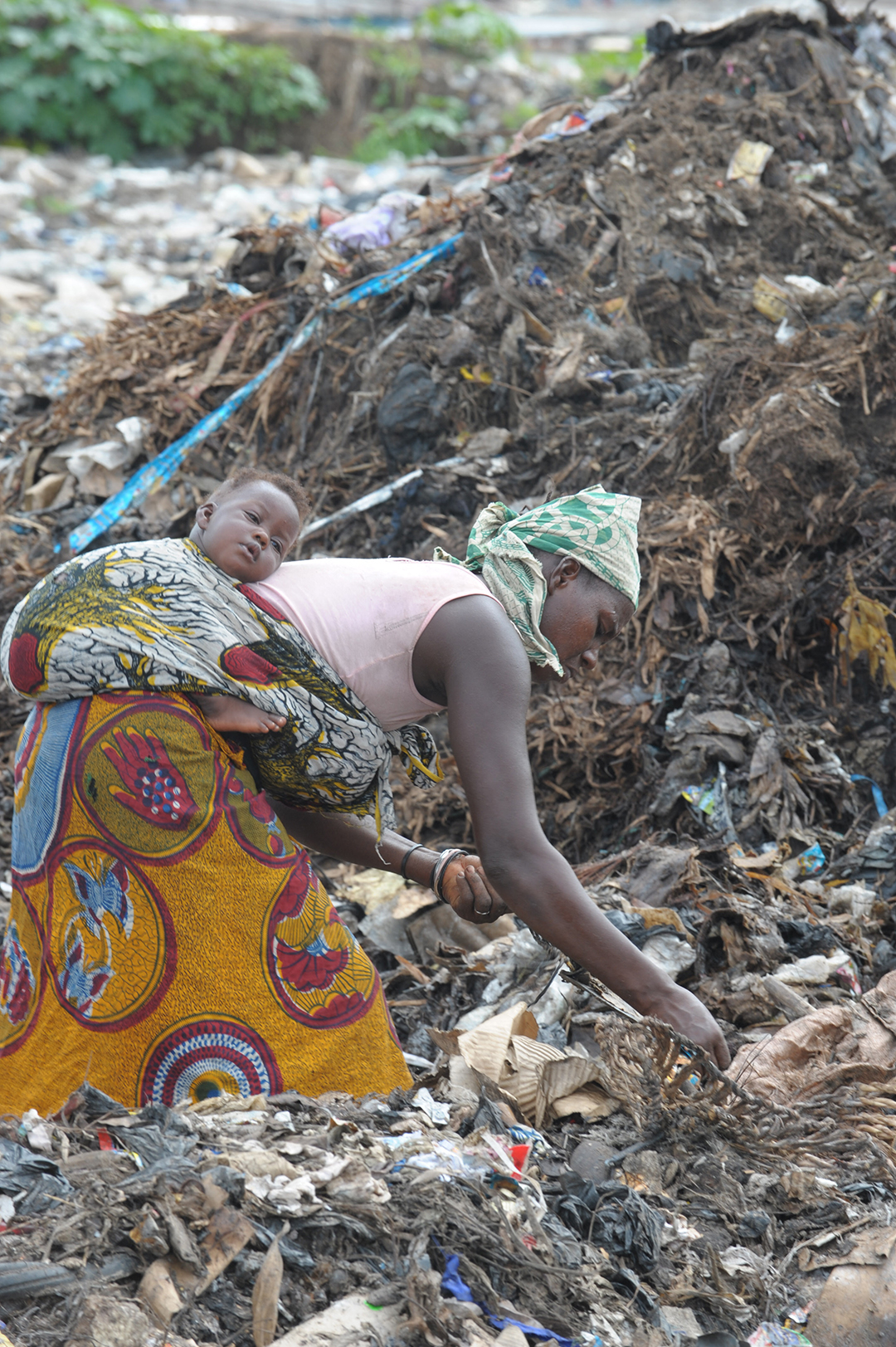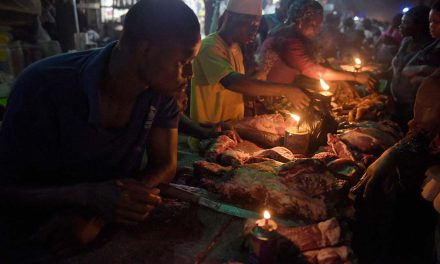Fisherman Claude van Leen has been sitting idle in Hout Bay harbour near Cape Town for six months because shifting winds have made the water too warm for his catch. He blames climate change.
“People are selling boats, and they are losing their livelihoods,” van Leen says in the cramped cabin of an old vessel. Normally jovial, the bulky 50-odd-year-old in blue overalls shakes his head and frowns. “We are all private fishermen here and just the five tuna boats lost about R5 million ($330,000) in October alone.”
African cities are some of the fastest growing in the world and millions of residents rely on fish for protein and livelihoods. The World Bank expects the continent to more than double its population to about 1.5 billion people by 2050. More than 12 million people are engaged in the fisheries sector in sub-Saharan Africa, the bank says. And it doesn’t stop there. For example, every fisherman’s job creates 1.04 additional onshore jobs in Mauritania, and 3.15 in Guinea.
Yet studies show Africa is warming faster than the rest of the planet, producing food crisis-inducing drought in some areas like Madagascar, widespread flooding in the Sahel and Rift Valley, while rising seas from melting ice caps will threaten coastal cities and island nations.

A woman with her baby looks for plastic waste through the rubbish at the Adjame dump of Abidjan, Cote d’Ivoire. Some industrialists have started waste recycling businesses, prompting poor people to collect plastic waste in dump sites around the country. Photo: Issouf Sanogo/AFP
Efforts to rein in global temperatures at the recent COP26 climate change conference in Glasgow failed to retire coal use. Financial institutions with $130 trillion in investments did say they’ll back measures to keep the planet from getting too warm, but critics like activist Greta Thunberg called it mere posturing or “greenwashing”.
African leaders at COP26 bristled at suggestions they would have to abandon the continent’s abundant fossil fuels when the continent is only responsible for 3% of greenhouse gases and just when the fuel is needed to propel its masses out of poverty. The economies of Nigeria, Angola, Libya and Algeria depend disproportionately on oil and gas production, while Mozambique has borrowed on future output from its offshore gas fields to the point of near financial ruin.
However, a new report emerged just before the conference showing how developing green technologies could spur returns on investment and mitigate climate change.
The Coalition for Urban Transitions, which advises governments on economic development and climate change, says in its September 2021 report, Financing Africa’s Urban Opportunity, that 35 African cities in three countries could leverage $280 billion in green investments into $1.1 trillion in benefits, nearly a fourfold return.
“Africa’s urban development is likely to confront unprecedented biophysical risks,” said the coalition, which is based in Washington, D.C., and London. “Three pillars will be crucial for low-carbon, climate-resilient urban development: compact urban growth, connected infrastructure, and clean technologies.”
South Africa will need $215 billion in investment in its cities by 2050, Kenya $27 billion and Ethiopia $42 billion, the coalition determined. These investment amounts are incremental, meaning they are the additional cost, for instance, to build a green building or buy electric transit vehicles above the baseline expense of traditional or fossil fuel options.
But gains could amount to $240 billion in Ethiopia, $140 billion in Kenya and $700 billion in South Africa. Cities would be more productive, healthier, less polluting, more inclusive, resilient to shocks and cheaper to run, the coalition says.
However, the wider continent needs trillions of dollars of investment to cope with climate change while budget constraints, high debt levels and low creditworthiness are barriers to cities raising the necessary capital, said the researchers.
“Weak fiscal regimes and thin economic bases at the city level make urban infrastructure in Africa a relatively unattractive proposition for private investors. The lack of creditworthiness and (lack of) fiscal decentralisation also prevents many cities from issuing green bonds,” they pointed out.
But Finnish company Nopea Ride is an example of a foreign private investor spotting an opportunity. It supplies electric taxis to the Kenyan capital Nairobi as the city implements a plan to cut passenger vehicle emissions by 16% by 2030. Drivers are attracted to the company because it allows free vehicle charging. Removing fuel costs allows drivers to increase their income by 30% to 50% compared with petrol cars, the company says.
Elsewhere, investors, such as Johannesburg-based investor Metier Private Equity, are filling the gap on some green energy projects led by international lenders and energy companies. Some projects are part of the South African government’s world-renowned Renewable Energy Independent Power Producer Procurement Programme. Metier is also pivoting to smaller projects in several other African countries as profit on large projects fall, and its funds target an internal rate of return of 25%.
Of particular interest to Ethiopia is how secondary cities are growing the fastest, as rural migrants searching for jobs increasingly shun the chaos of megacities. Lower water availability and crop productivity alongside rising seas and storm surges are expected to force 86 million Africans to find new homes by 2050, according to the United Nations World Meteorological Organization. East Africa alone could see up to 12.1 million climate migrants, it says.

A local cobbler walk past smoke emitted from a dump in the city of Port Harcourt. The Nigerian city used to be known as “The Garden City”, but latterly black soot has fallen, angering residents who claim nothing is being done to protect their health. Photo: Pius Utomi Ekpei /AFP
The World Bank is targeting secondary cities by funding projects to reform institutional planning, finance and governance as well as infrastructure in Ethiopia ($800 million), Uganda ($360 million), Rwanda ($255.5 million), Kenya ($300 million) and Somalia ($170 million), according to Peter Ellis, the World Bank Practice Manager for Urban Disaster Risk Management for eastern and southern Africa.
“These are new frontiers for growth and development in the region,” Ellis said in an interview. “We are not currently promoting any specific green technology.”
Still, one of those World Bank projects in Ethiopia is $300 million to improve Addis Ababa’s transit system as the capital city’s population of five million increases by 4% a year. Despite new bus routes, more light rail transit and traffic management systems, the majority of residents choose walking or inefficient minibuses for travel. This situation echoes many African cities. Minibus drivers, fearing for their jobs and backed by criminal gangs involved in ownership schemes, are known to intimidate riders to use the polluting vehicles instead of public transit.
The Coalition says changing the city to low-carbon transit would require $6.5 billion in incremental investment to 2050, but will deliver $56 billion in benefits and create 30,000 net jobs compared with fossil fuel-based developments.
In many cases of the green economy that must replace fossil fuels to reach climate targets, the new jobs created aren’t the same as those to be replaced. However, driving a bus spewing black exhaust or one that plugs in occasionally is still driving a bus.
The Coalition emphasises that countries need to improve revenue collection. That would be helped by greater autonomy for cities from national governments, or fiscal decentralisation. In this way, Kenya created 47 county governments in 2013.
Kenya’s budget this year included a boost to private investment in electricity generation by ending the government’s monopoly, while adding multiple measures to increase revenue. These included more taxes on internet businesses, mining, sweets and betting, according to an analysis by KPMG.
Climate mitigation decisions in southern African cities are heavily influenced by uncoordinated foreign donors, largely because there’s little local public revenue generated and settings are complicated by widespread unregulated construction, says Anna Taylor, a research fellow with the African Climate and Development Initiative at the University of Cape Town.
“There are serious capacity constraints on implementing policies, strategies and plans, at all levels of government but especially at local government level,” Taylor wrote last year in the Stockholm Environmental Journal. “Climate information needs to guide formal decision processes, but collaboration and learning across formal and informal actors are essential to address the lived realities of urban climate risk.”
While the Coalition calls for compact urban development, Nick King, who teaches sustainability and futures thinking at the University of Stellenbosch east of Cape Town, instead argues against dense cores requiring people to travel to them for work where they are fed electricity from plantations of renewable energy generators.
“There is no need for huge solar farms, we can install solar panels inside cities, covering rooftops,” King said in an interview. “But most importantly, we need to decentralise.”
That will reduce greenhouse gases from less transit, alleviate pressure for resources and living conditions in the core, allow people to work closer to home and give them access to less expensive food grown locally, he says.
Indeed, the Coalition cites how Durban in South Africa has so far installed 500 kilowatts of photovoltaic solar power atop rooftops in a quest to divert 40% of electricity demand to renewables by 2030. The city requires $1.3 billion in incremental rooftop solar spending by 2050 to reap $2.8 billion in benefits, the researchers said.
Elsewhere in South Africa, climate change has manifested itself in warmer oceans for fishermen like van Leen, while arid tinderbox conditions sparked fires this year destroying part of the University of Cape Town after a drought two years ago nearly sucked dry the city’s water supply.
In Hout Bay harbour, van Leen worries about changing weather patterns. There are western winds in September when fishers usually depend on south-easters to upwell baitfish. Water temperatures are hitting 22°C when they used to be 18°C, he says.
“We used to travel about five nautical miles from port, now we have to go as far as 40 nautical miles to get anything,” van Leen says. “The water is just too warm here and we have to go closer to the Arctic to catch anything.”
It’s not just humans at stake. Africa’s warming oceans are driving away everyone’s favourite catch. Amos Ripenga at the Seal Rescue Institute in Hout Bay says there’s been an unprecedented number of dead seals washing up on the shores of the Western Cape this year.
“The seals are starving,” Ripenga says. “I’ve been here for three years, and I’ve seen nothing like it. It just keeps getting worse.”
Would you like to gain an understanding of your own impact on the environment? Calculate your own carbon footprint here













